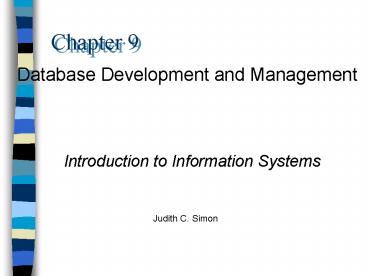Simon Text Book - PowerPoint PPT Presentation
1 / 14
Title:
Simon Text Book
Description:
Database: designed to be shared by many people, although the on-screen data and ... Refers to designing a database by using related models, starting with a high ... – PowerPoint PPT presentation
Number of Views:22
Avg rating:3.0/5.0
Title: Simon Text Book
1
Chapter 9
Database Development and Management
Introduction to Information Systems
Judith C. Simon
2
Chapter 9 Major Topics
- General concepts
- File organization
- File access
- Data models
- Distributed databases
- Data warehouses and data mining
- Knowledge management
3
General Concepts
- Metadata data about data, such as descriptions
and relationships - Database designed to be shared by many people,
although the on-screen data and reports may be
entirely different for each individual need - Entity each person, place, or thing that is a
basis for maintaining data - Attribute individual characteristics about an
entity
4
File Organization
- Refers to the way data is stored, i.e., the
relationship between a record and its location in
a file - Address actual storage location for a record
two types - physical, e.g., cylinder, track and sector used
on a disk - relative, e.g., records position in a file in
relation to the beginning of the file can be
used to create a linked list (pointers), with
each record pointing to the next related record
by including its relative address
5
File Organization, continued
- Types of file organization include
- Sequential records stored in a specific order,
such as alphabetically, by date, by order number,
etc. - Indexed sequential records divided into groups
and then arranged sequentially within each group - Random ( or direct) records stored in any
order, with physical location not a concern for
location records later
6
File Access
- Concerned with retrieving of files two options
are - Direct (or random) requires that one or more
fields be used as a key, or unique identifier
for a record example social security number or
customer account number, where no two records
would have the same number - Sequential files are presented in order from
the first or current record to the last in the
designated order
7
Data Models
- Refers to designing a database by using related
models, starting with a high-level model of some
activity, followed by more detailed models,
eventually leading to a model identifying details
of implementation - Conceptual data model depicts needs from system
users viewpoints - Logical data model based on conceptual model
and includes description of items that need to
work together and other related details often
used for communications between developers and
users
8
Examples of Logical Data Models
- Hierarchical top-down (tree) structure main
element is at the top, branching down from there
efficient but somewhat inflexible structure for
data flow (hierarchical is a one-to-many
relationship) - Network has multiple paths for data flow more
complicated to design and manage but reduces
unnecessary redundancy (network is a many-to-many
relationship)
9
Examples of Logical Data Models, continued
- Relational relations are shown as
two-dimensional tables, with attributes used as
columns (fields) linking to another table can
occur by having one column of data that is the
same in both most widely used model - Object-oriented reusable system that includes
- class person, place, or thing of interest
- object instance of a class, containing related
data and methods - inheritance new classes can use characteristics
of existing classes
10
Database Management Systems
- Refers to a complex set of programs for managing
databases - Management tasks include
- controlling access to data
- coordinating the shared use of data
- maintaining quality or integrity of data
- managing input/output operations to ensure that
they are as efficient as possible - monitoring system performance
11
Distributed Databases
- Uses multiple desktop and other computers to
spread the databases over different geographic
areas in a network - General designs include
- placing parts of a database in the locations
where they are most needed - copying (replicating) the entire database at one
or more separate locations - Entire system will not be shut down from a single
power failure, but development and management are
more complex
12
Data Warehouse
- Typically uses a centralized data storage system
- Used for long-range decisions rather than
real-time or online decisions - Contains recent as well as historical data but
does not contain up-to-the-minute data that is
constantly changing - Contains integrated data from multiple business
activities, typically arranged by subject - Houses both detailed and summary data
13
Data Mining
- Involves accessing a data warehouse to examine
data, often to locate patterns and relationships
among items that might not otherwise be noticed,
as well as other influences in a set of data - Often involves neural network techniques that can
adjust as new examples are encountered, combined
with decision support tools - Widely used for marketing activities, sometimes
to predict customer behaviors
14
Knowledge Management
- Refers to systems that include storage of
knowledge of various employees that can then be
shared with others (their knowledge includes such
things as methods they have used for successful
handling of situations and other procedures that
are not otherwise found in programs or databases)
- Often used to assist in business decisions or to
improve customer service












![READ [PDF] A Funny Thing Happened on the Way to the Forum (Applause Librett PowerPoint PPT Presentation](https://s3.amazonaws.com/images.powershow.com/10046139.th0.jpg?_=20240603065)



![❤[READ]❤ Why We Need Love (Harperperennial Modern Thought) PowerPoint PPT Presentation](https://s3.amazonaws.com/images.powershow.com/10047331.th0.jpg?_=20240604102)











![Download [PDF] Fatherland (Modern Plays) PowerPoint PPT Presentation](https://s3.amazonaws.com/images.powershow.com/10091835.th0.jpg?_=20240803019)


